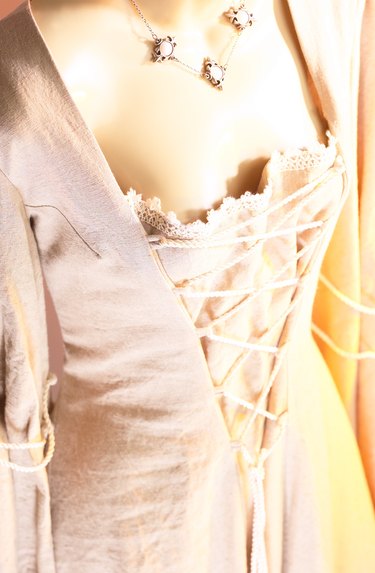Things You'll Need
Dress fabric
Rat-tail or satin-covered cording
Measuring tape
Scissors
Dressmakers pins
Thread

Buttons and zippers may be the norm for present-day dress closures, but loops laced with ribbon are still found on formal wear or period costumes. Loops can be added to a dress in a number of ways, including purchasing and attaching ready-made strips of loops. However, you can create matching loops for a custom gown or wedding dress by sewing corded loops with bias strips from your dress fabric.
Step 1
Measure the opening of the dress to determine the length of covered cording you will need. A good rule of thumb is two inches of cording per loop and one loop per inch of opening.
Video of the Day
Step 2
Create a bias strip by folding a piece of your dress fabric diagonally, the selvedge edge even with the raw edge. You should have a triangle. Cut your strip along the fold. This is a bias strip and it will be stretchy. Cut the strip wide enough to wrap around the cord with an additional 3/4-inch seam.
Step 3
Measure and cut twice the length of cording you needed for your closure loops plus 1/4 inch. Measure and cut the length of the bias strip needed for the loops plus an extra 1/4 inch. Fold the bias strip over the cord, right sides together. Half the cord should be uncovered.
Step 4
Sew across the bias strip 1/4 inch from the end at the middle of the cord. Use a zipper or cording foot on your machine. Sew through both layers of fabric and the cord, securing the cord. Pivot and sew close to the cording up the length of the bias strip.
Step 5
With your fingers work the fabric down over the uncovered length of cord. Once the fabric is started and the opposite end of the cord is exposed, use the cord to help pull the fabric inside out over the uncovered cord. When finished, the tube will be turned right-side-out over the previously uncovered cord.
Step 6
Trim off the excess cord length. Shape the cord into loops and pin in place at the dress opening. Machine-stitch into place. You can make a grid on a sheet of paper to help assure that the loops are even and correctly spaced.
Tip
Stitch your loops to seam tape before stitching them to the dress. If your dress is lined, hand-stitch the lining in place after the loops are attached. Adjust the loop size according to the size of your buttons. Round single stemmed buttons work best with loops. Rat-tail or satin-covered cord can be found in fabric stores. It is cotton cord with a slippery, satin outer layer.
Video of the Day